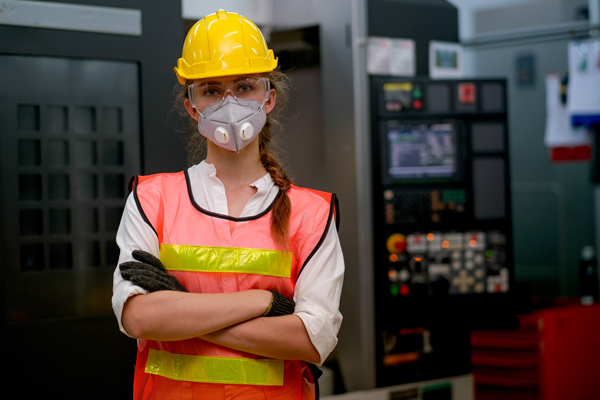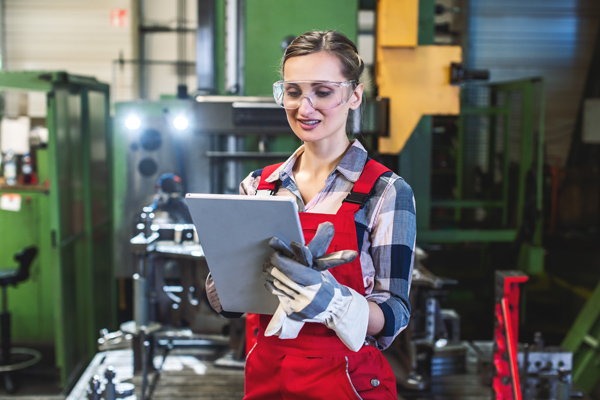Overview
- Some manufacturers are preparing to get back to work and grow their workforce to pre-pandemic levels.
- Companies must adjust to the ‘new normal’ to safeguard their operations and workforce.
- 94% are adjusting operations to meet new social distancing guidelines.
- Outdated manual process that do not support social distancing will no longer suffice, meaning manufacturers must adapt now.

The recent COVID-19 pandemic has caused many manufacturers to temporarily shift or close operations. Remote administrative staff, enhanced safety measures and social distancing have further altered workflows. For many manufacturers, demand has been relatively stable, but an adequate workforce and productivity remain a challenge.
Now, as states relieve stay-at-home orders, some manufacturers are preparing to bring their production employees back to pre-pandemic levels. When they do, manufacturers won’t just be able to return to the status quo. Instead, they must adjust to the ‘new normal’ brought by COVID-19. Retaining manual processes will simply no longer be an option in order to keep workforces safe and production running.
Technologies, such as mobile barcoding and automated data collection, are uniquely suited to facilitate this transition.
Also Read: How Mobile Barcoding supports COVID-19 safety measures »
Social Distancing is Here to Stay
Boeing resumed work earlier this week at its Seattle-area plants after a lengthy shutdown. Other manufacturers are set to follow suit.

However, the social distancing and enhanced safety measures put in place at the onset of COVID-19 disruptions will continue even as manufacturing ramps up production.
According to a recent Kardex survey on the impact of COVID-19 on warehouse professionals, 94% of companies are adjusting operations to meet new social distancing guidelines. 44% of workers are currently working remotely and 35% are rotating between working at home and being onsite.
Administrative staff will continue to work remotely and social distancing measures will need to stay in place, or manufacturers risk production stoppages due to sick workers or walkouts, as seen most recently with Amazon.
Failed compliance may also risk OSHA violations, which has released advice specifically for manufacturers operating during this time, resulting in penalties, increased oversight or production delays.
So, how do we safely rebuild our manufacturing workforce and boost production?
One way is to adopt shared best practices for your industry and transformative technologies, such as mobile barcoding and data collection.
Built on supply chain best practices, mobile barcoding combines handheld scanning devices and strategic mobile apps to extend ERP data to point-of-work, enabling workers to record inventory movements in real time.
Why is Mobile Barcoding Critical Now?
According to a recent survey, 77% of those interviewed agree that they need to modernize operations, but are currently slow to implement new devices and technology. Now is the time to prioritize digital transformation projects, such as mobile barcoding, and speed up implementation timelines in order to build a resilient supply chain – or risk the ability to even remain operational.
Read More: Why a Digital Supply Chain is a Necessity in the Age of COVID-19 »
How Mobile Barcoding Supports COVID-19 Safety

By replacing paper processes with mobile barcoding technology, manufacturers can support existing and future safety measures as state restrictions begin to ease.
Mobile barcoding technology helps facilitate important health and safety measures for COVID-19 by:
- Eliminating hand-to-hand paper transfers and typing into a shared workstation, to reduce the risk of COVID-19 transmission.
- Updating your ERP in real-time, without any intermediary steps, such as writing, scanning and emailing inventory workflows to offsite admin staff. This boosts efficiency while simultaneously reducing the possibility of COVID-19 transmission.
- Providing long-range barcode scanning capabilities of 50-feet or more with enterprise devices. This reduces the physical closeness of workers and unnecessary entering of shared physical spaces to meet social distancing measures.
- Enabling remote communication between management and the workforce, reducing the need for in person and/or onsite meetings.
Mobile technology will also be key to increasing productivity during labor shortages, as workers are empowered to accomplish as much or more than they did pre-pandemic, even with the current safety restrictions.
The influx of COVID-19 cases may also ebb and flow as society returns to normal, causing fluctuations in workforce numbers. You can minimize their effects by planning for reduced numbers and disruptions now.
Conclusion
Manufacturers who blindly keep operating as if the supply chain will return to normal will be unprepared for the reality – the new supply chain is here to stay.
You may have been able to make do with extra inventory, added overhead costs and manual recording processes in the past. But no longer.
Mobile technologies that support COVID-19 safety and augment productivity during the ‘new normal’ are necessary. Manufacturers must adapt to stay competitive and do their part in securing a resilient supply chain that can weather the challenges of today, as well as the unforeseen future.






